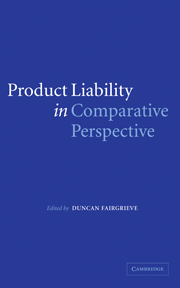Book contents
- Frontmatter
- Contents
- List of figures
- Foreword by Sir Michael Burton
- List of contributors
- Preface
- 1 Introduction
- PART I Country reports
- 2 The use of comparative law in A & Others v National Blood Authority
- 3 Spanish product liability today – adapting to the ‘new’ rules
- 4 Interaction between the European Directive on Product Liability and the former liability regime in Italy
- 5 L'Exception française? The French law of product liability
- 6 German product liability law: between European Directives, American Restatements and common sense
- 7 Dutch case law on the EU Product Liability Directive
- 8 Defect in English law – lessons for the harmonisation of European product liability
- PART II European influences
- PART III Comparing systems
- Appendix
- Index
7 - Dutch case law on the EU Product Liability Directive
from PART I - Country reports
Published online by Cambridge University Press: 28 July 2009
- Frontmatter
- Contents
- List of figures
- Foreword by Sir Michael Burton
- List of contributors
- Preface
- 1 Introduction
- PART I Country reports
- 2 The use of comparative law in A & Others v National Blood Authority
- 3 Spanish product liability today – adapting to the ‘new’ rules
- 4 Interaction between the European Directive on Product Liability and the former liability regime in Italy
- 5 L'Exception française? The French law of product liability
- 6 German product liability law: between European Directives, American Restatements and common sense
- 7 Dutch case law on the EU Product Liability Directive
- 8 Defect in English law – lessons for the harmonisation of European product liability
- PART II European influences
- PART III Comparing systems
- Appendix
- Index
Summary
Introduction
The Dutch Act to implement the European Directive on Product Liability (PL) entered into force on 1 November 1990. Since 1 January 1992 the relevant provisions can be found in art. 6:185–193 BW. According to these provisions the producer may invoke the development risk defence (art. 6:185 s. 1 sub e) but the liability of the producer is not limited (art. 16 Directive).
Since the Directive had to be implemented on 30 July 1988 (art. 17 Directive), the Netherlands exceeded this term by more than two years. There are two published cases as regards damage caused by products which were put into circulation between 30 July 1988 and 1 November 1990. In one case the court (Hof Leeuwarden) explicitly interpreted Dutch law in accordance with the PL Directive. In another case the Hoge Raad did not make clear whether or not it did so.
In the implementation Act, the Netherlands did not provide a limitation of the liability of the producer, which would have been possible according to art. 16 of the Directive. Neither did the Act derogate from Article 7(e); this provision implies that the producer can invoke the development risk defence (see also para. 2).
The previous Dutch case law with regard to product liability did not differ much from the PL Directive. In the Halcion decision the Hoge Raad held that it is unlawful (onrechtmatig) to put a defective product into circulation, using the same definition of defect as in art. 6 of the PL Directive.
- Type
- Chapter
- Information
- Product Liability in Comparative Perspective , pp. 126 - 137Publisher: Cambridge University PressPrint publication year: 2005
- 1
- Cited by

